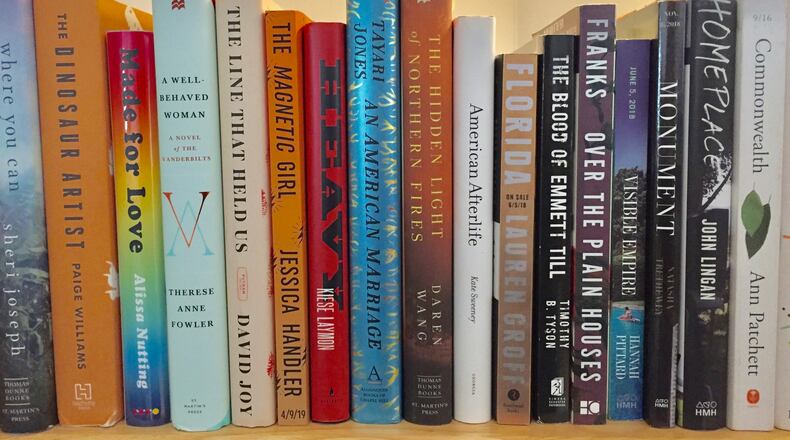Fictional tales of dark doings in the hollers and hamlets of Appalachia have become so prolific in recent years, they've spawned their own genre: Appalachian noir. North Carolina author David Joy is one of its leading proponents. But his third novel, "The Line That Held Us," is straight up Southern gothic, and it is as horrifying and delicious as that label suggests.
It takes a while for Joy to reveal just who is at the center of his violent tale. At first it appears to be Darl Moody, whose ill-fated hunt for an elusive buck sets the story in motion when he mistakenly shoots and kills Sissy Brewer, “a half-wit born to a family Jesus Christ couldn’t have saved.” Both men are trespassing in Coon Coward’s woods when the accident occurs. Sissy is stealing ginseng, and Darl is hoping to fill his empty freezer, despite the fact it is off-season.
The focus then shifts to Darl’s friend, Calvin Hooper, who helps Darl conceal Sissy’s death and later comes to regret it. Calvin is the one person who has the most to lose as the comfortable life he took for granted begins to unravel.
Eventually the narrative settles on Sissy’s brutish brother, Dwayne Brewer, a lone vigilante “built like a concrete pillar,” who metes out cruel punishments to anyone who transgresses his idiosyncratic sense of justice.
We first meet Dwayne when he watches a cocky teenager humiliate an awkward boy in the shoe department of Walmart. The bully’s victim reminds Dwayne of Sissy, and nothing fuels Dwayne’s rage like the thought of harm coming to his little brother. When he corners the bully in the public restroom, Dwayne delivers a creative but repulsive form of retribution and makes the observation that, “the kid might’ve been all right if it had been a gun to his head every second of his life,” a hat tip to the queen of Southern gothic, Flannery O’Connor, from whom Joy lifted the phrase.
Despite its brutality, "The Line That Held Us" is, at its core, about fraternal love and loyalty, and just how far a man is willing to go for his friend or brother. Calvin's dedication to Darl is something of a revelation, considering they come from a stock of rough-hewn men who "never let emotion show or opened their hearts with their tongues."
But Calvin’s allegiance pales compared to Dwayne’s devotion to Sissy. “All his life he’d felt a responsibility to shield his younger brother from harm, to ensure that he took the brunt of whatever pain this world dealt because he was tough enough to bear it.”
While Calvin’s dedication to Darl leads him to compromise his morals, Dwayne’s devotion to Sissy turns deranged, morphing into bloodlust.
There are distinct parallels between Darl and Sissy. They are both loners and trespassers who disregard the law and their neighbor to get what they want. Both come to grotesque ends.
The parallels between Calvin and Dwayne are less obvious. The implication is that Dwayne might have been a good man, too, had he grown up with the same advantages as Calvin, starting with a loving family. Instead, Dwayne and Sissy are abused and neglected by their parents, who die in a car wreck that “was neither an accident nor a shame.” The community treats the brothers no better, shaming them the one time they attend a church service.
Joy sets his story against a landscape that is in the midst of an uneasy transition. Tensions in the mountain community fester between the conflicting interests of tradition and technology, townies and newcomers, landowners and developers. While much of the action takes place in locations such as a root cellar, a barn and a falling-down house, it is telling that a pivotal showdown between Calvin and Dwayne transpires on the building site of a new housing development.
It’s also noteworthy that “The Line That Held Us” is set in a world where women have little presence. The one significant female character is Calvin’s girlfriend Angie, who is beautiful and maternal and fierce. But ultimately she is one-dimensional and only comes into play in the service of a plot point toward the end. The rest of the community’s womenfolk are dispensed with the observation that they “were used to loss, accustomed to never having enough. They were fit for the harshness of this world.” Unlike the men, Joy seems to imply. The men in “The Line That Held Us” are restless and easily provoked. Violence and transgression are their currency for attaining or maintaining position. “This world is about power, (Dwayne) thought. This world is about those born with it and those who take it for themselves.”
There is one niggling thought that creeps in the back of the mind while reading “The Line That Held Us.” Had Darl or Calvin just gone to the authorities, some of the tragedy that transpires might have been thwarted. People get away with hunting accidents all the time. But once Joy’s story gains momentum and gallops to its gripping conclusion, questions about plausibility recede into the background.
The final scene is ambiguous and chilling. It hearkens back to the line Joy lifted from O’Connor, uttered by a ruthless killer called the Misfit in her short story, “A Good Man Is Hard to Find.” Joy’s conclusion seems to suggest that his tragic tale is a stand-in of sorts for the universal Misfit’s origin story.
FICTION
“The Line That Held Us”
By David Joy
G.P. Putnam’s Sons
256 pages, $27
About the Author
Keep Reading
The Latest
Featured





